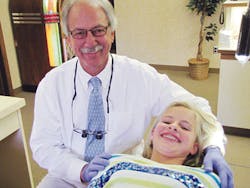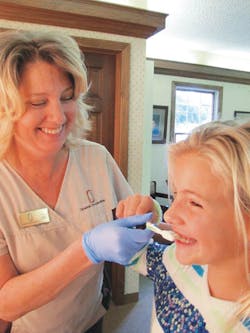A creative approach to care fosters better orthodontic outcomes
BY Nicole Giesey, RDH, MSPTE
As dental hygienists, we hold the title of leaders in oral hygiene. Our patients look to us for leadership, guidance, and education. It is our obligation to fulfill the needs and expectations of our patients. It can be a challenge to have patients comply, especially our tween and teenaged patients. Adding the blockade of wires, bands, and brackets can sometimes complicate things.
Tween patients are a challenge to motivate even before orthodontic treatment, so how can we optimize our time and help these patients achieve their oral hygiene goals? Knowing that we're part of a bigger team can certainly provide some relief. When an orthodontic patient starts treatment, hygienists enter a co-treatment relationship with the orthodontic team treating the patient. Hygienists play a unique role in treatment when it comes to orthodontics. Many times patients will have their treatment interrupted or stopped due to many failed attempts to improve poor oral hygiene. By going the extra step, hygienists can help prevent negative outcomes and experiences. There are many ways we can help patients obtain their goals, such as research, organization, motivation, education, and communication. An orthodontic program or protocol that encompasses these goals is ideal.
---------------------------------------------------
Other articles by Giesey
- Trust in clean hands: Routine hand washing techniques helps instill confidence in battle against cross contamination
- Oral cancer screening update: Targets, techniques, and technology help ensure compliance with screening protocols
- Career re-entry: Stepping back into the profession in a crowded market is a daunting challenge
---------------------------------------------------
The orthodontic program in your office can be as simple or as elaborate as the dental team chooses. It can be as simple as providing patient education and support, or as elaborate as being a constant advocate, providing tailored care, and being a cheerleader for your patients. You can be as creative with this as you want.
Patient retention is a priority in every dental office. Simple specialty programs for your patients can set you apart from the competition. Tailored care is a win/win for patients and hygienists. The purpose of the program is to keep track of ortho patients, keep a history of their hygiene status, identify areas that need improvement, create a personalized hygiene treatment plan during orthodontic therapy, and organize communication with the orthodontist. The program has to be assessed to ensure its objectives are being met. Having a specialty protocol does not have to cost a lot of money, involve consulting, or take a lot of time. A good place to start is to research current information.
Research is the first step and an ongoing process, as new research and products are always emerging. Hygienists can start by having the most current information available on products, treatment modality trends, and current evidenced-based research on orthodontics. Online product catalogs are good for looking at current gadgets. An online search for orthodontic hygiene products will produce more results than company catalogs. Many times manufacturers will provide a sample if you request one. Also, visiting the drugstore and browsing in the orthodontic area will help your patients. Write down what stores have which products and create a list to share with patients.
Reading and attending CE seminars will keep current information at your fingertips. Gathering all this information and formatting a personalized list that can be tailored to your patients will be a valuable educational tool. This can be a list of products with the names of the stores where they are available, or the list can provide pictures of the items for easy identification, and a summary of how the products should be used. Patients will appreciate any help you give them because they are often overwhelmed in the office and forget the information. A written form with all the information for homecare also benefits patients.
Flagging ortho patients from the rest will allow you to quickly identify and prepare for those patients. Flagging is also a good idea for special-needs patients, fearful patients, and any patients you want to identify to successfully prepare yourself. Flagging can be a simple color sticker on the outside of the chart, or a flag in the patient's notes on the computer. You can prepare patient education materials and a list of products. You can review the last recall charting, any correspondence from the orthodontist, and the patient's chart for any special instructions.
If possible, having a sample in the office to show patients and demonstrate on models is excellent for patient education. This can be accomplished while waiting for your exam. Having patients use the products on the models to get a feel for them is beneficial. Creating an ortho program binder with monthly tabs in order to add patients between their recall visits is easy to create, and you can refer to it for a monthly call list. Keep a list of names and numbers and the area a patient is struggling with. For example, you can ask patients how many times a week they use their Water Pik. Ask open-ended questions so patients have to explain instead of answering yes or no. Your enthusiasm is the fuel that keeps patients interested and engaged.
Hygiene motivation
"In order to succeed, we must first believe that we can" is a quote from Nikos Kazantzakis. This is ideal for ortho patients. Patients with subpar hygiene are a challenge to educate and inspire. One goal for hygienists is to put the responsibility of good oral hygiene in the hands of each patient. After all, we get to clean their teeth only a limited number of times a year, whereas they clean their teeth daily. Motivating patients to do a dental hygienist's standard cleaning every day is our goal. We want them to want to have good oral hygiene and the positive feelings that come with a confident smile, even with orthodontics. A smile is a smile, whether a patient is wired or not.
I spoke with an orthodontist, Dr. Ted Opalka, who said his office has a motivational program for good dental hygiene. The program encourages patients to practice good hygiene between adjustments, and avoid any foods that could break brackets or appliances. If they do this, patients are entered into a monthly drawing for a mall gift certificate. Dr. Opalka also assesses patients' hygiene to see if any part of their routine is being missed. He and his staff will revisit proper hygiene care with patients and their parents if a routine is not ideal. Each patient receives an oral hygiene pack with instructions at the start of treatment, and patient education is reviewed thoroughly. Good oral hygiene measures are extremely important to Dr. Opalka because he wants the best outcome for his patients. Unfortunately, if oral hygiene measures are poor, even after multiple efforts to correct a problem, the braces may have to come off and the orthodontic treatment interrupted. Motivation from both the general dentist and orthodontist will benefit patients. This is why communication with the orthodontist is crucial (see related sidebar).
The mouth mirror is very helpful for people with braces to help them see foreign objects that are poking them or are stuck. These are available in most drugstores, as are Monoject syringes. Monoject syringes are a must-have to irrigate those hard-to-reach places. In conjunction with brushing with a small-headed toothbrush, a good flossing aid is Super Floss or a floss threader. The fluoride of choice for Dr. Opalka is Phos-Flur because it can deeply penetrate enamel. Another good product for ortho patients is L'il Palates Sweepers to clear out the palate expander. There are several rinses that are good for appliance care, such as Efferdent, good old-fashioned vinegar-and-water rinses, Fresh Guard, and Retainer Brite.
Overall, we are one unit of dental caregivers that are subdivided. In order to really care for our patients who are being seen by a specialist, we need to communicate clearly and efficiently. Being organized and up-to-date on current trends will enable hygienists to provide superior care, and superior care should be our goal always. RDH
Communication with the orthodontist
When communicating with orthodontists who are treating your patients, it is important to understand how their offices address oral hygiene. If a patient is doing poorly and the orthodontist is not getting through to them, the teams can use a different angle. If there has been no correspondence between offices regarding a patient with poor hygiene habits, call the office and introduce yourself. Ask what types of patient education they use and what their goals are. Work as a team with positive goals for the patient. People learn in different ways. Maybe the orthodontist explained a method, but the patient is a visual learner. Maybe it is a compliance and motivational issue.
Having documentation of the conversation or correspondence will help as a guide in the patient's future care. Implementing a three-month recall instead of the standard six months might help monitor the patient, as well as save money in the future. Some orthodontists place lingual fixed retainers that inhibit flossing and create a dental hygiene nightmare due to their cervical placement. Ask the orthodontist what he or she would like you to do in this situation. Many orthodontists like to see patients to follow up on their retainers and make sure there are no hygiene issues that can cause a larger perio problem.
Another thing you can discuss with the orthodontic office is what protocols they have regarding brushing, and what types of brushes, extra hygiene products, and fluorides they recommend. You don't want to recommend something that the orthodontic office does not recommend. Everyone has to be on the same page or the patient will become confused and not comply.
Nicole Giesey, RDH, is a private practice hygienist and enjoys writing, researching, and motivating within the field of dental hygiene. She can be reached at [email protected].









